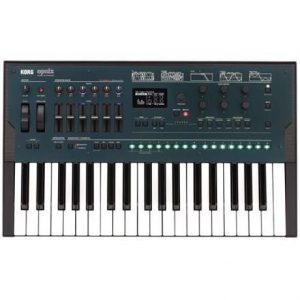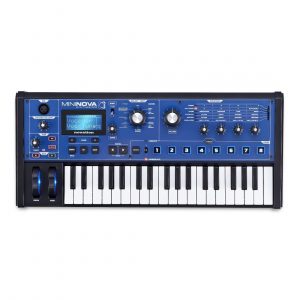Behringer MS-101
$203.99
Get the classic sound of an analog synthesizer with the modern ease of use of the Behringer MS-101.
Compare
Description
Behringer has taken the world of synthesizers by storm with the introduction of the Behringer MS-101 Synthesizer. This synthesizer is designed for musicians, sound designers, and composers alike, with a wide range of features that enable users to create unique sounds, melodies, and rhythms.
The MS-101 is an analog synthesizer modeled after the iconic Roland SH-101. It features a 32-step sequencer, arpeggiator, and a unique distortion circuit that can add grit and warmth to any sound. The synthesizer’s voltage-controlled oscillator (VCO) and filter ensure that the sound can be manipulated in a variety of ways, while the envelope generator and LFO give users even more control over the sound’s shape and modulation.
One of the standout features of the MS-101 is its compact and portable design. It is easy to carry around and can be used in a live performance setting without taking up too much space. Despite its small size, the synthesizer has a lot of power and versatility, making it a great option for both professional and amateur musicians.
The MS-101 also boasts a user-friendly interface that is easy to navigate. The knobs and buttons are large and intuitive, making it easy to adjust the settings and create new sounds. The sequencer is also very user-friendly, with a simple layout that makes it easy to program a sequence and save it for future use.
Overall, the Behringer MS-101 Synthesizer is a welcome addition to the world of analog synthesizers. It offers a great balance of power, versatility, and user-friendliness, and is a great option for anyone looking to create unique sounds and explore the world of electronic music.
Behringer MS-101 properties
| Product name |
MS-101 |
| Brand |
Behringer |
| Type |
Keyboard Instruments |
| Keyboard Instrument |
Synthesizer |
| Keys |
Yes |
| Number of Keys |
37 pcs |
| Key Functions |
Semi Weighted |
| Drawbars/Sliders |
Yes |
| Rotary Controls |
Yes |
| Connections |
6.3mm (1/4″RTS), Headphone, MIDI, MIDI In, MIDI Through USB, MIDI Thru |
| Colour |
Black, Blue, Red |
| Power Supply |
Electrical Cable to Wall Socket |
Frequently Asked Questions:
What are the primary differences between the Behringer MS-101 and original Moog Model 101 synthesizers, and how does this affect their functionality and sound?
The Behringer MS-101 and the original Moog Model 101 are both monophonic analog synthesizers. However, there are several primary differences between them that can affect their functionality and sound. Firstly, the MS-101 is a budget-friendly alternative to the original Moog Model 101, which was discontinued in the late '80s. Behringer is known for producing affordable clones of popular synthesizers, and the MS-101 is no exception. Secondly, the MS-101 has a slightly different layout and design compared to the original Model 101. The MS-101 features a more modern interface with LED displays, while the Model 101 relies on analog VU meters for level indication. Additionally, the MS-101 has a built-in arpeggiator and sequencer, which were not present in the original Model 101. In terms of sound, both synthesizers use analog oscillators to generate their sounds. However, there are some differences in the specifications of these oscillators that can affect the overall tone and character of each instrument. The MS-101 uses a combination of analog and digital circuits to create its sounds, while the original Model 101 relies solely on analog circuitry. Some users have reported that the MS-101's sound is slightly less "warm" or "analog" than the original Model 101 due to these differences in design and technology. Overall, while there are some notable differences between the Behringer MS-101 and the original Moog Model 101, both synthesizers offer a similar experience for those looking to explore monophonic analog synthesis. The MS-101 may not have quite the same sound or build quality as the original Model 101, but it is an affordable alternative that still offers a rich and versatile sonic palette.
How can I calibrate the MS-101's internal voltage reference to ensure accurate and stable operation within its intended range?
To calibrate the MS-101's internal voltage reference, follow these steps:
1. Connect a voltmeter or digital multimeter (DMM) with an accuracy of at least 0. MS-101's voltage reference. The MS-101 has two output pins labeled VREFP and VREFN. These pins should be shorted together for internal calibration. Power on the MS-101 and allow it to stabilize for at least 30 minutes. This ensures that any initial voltage drift has settled. Measure the voltage output at the VREFP/VREFN pins using the DMM. The voltage should be within the specified range of 2. V ± 1% (maximum) for the MS-101. If the measured voltage is outside this range, proceed to step 4. Contact your supplier or manufacturer for a calibration service. They will provide you with a calibration certificate that details the new calibrated voltage reference value. Alternatively, you may choose to perform the calibration yourself using specialized equipment and procedures. To update the internal voltage reference value on the MS-101, follow these steps:
a) Power off the MS-101 and remove any power supply connections. Short the VREFP/VREFN pins together with a jumper or shorting cable. Apply an external voltage source to the VREFP/VREFN pins, which should be equal to the calibrated value minus the MS-101's internal offset voltage (typically ±2 mV). The MS-101's internal voltage reference will now track the applied external voltage. Power on the MS-101 and allow it to stabilize for at least 30 minutes. Measure the voltage output at the VREFP/VREFN pins using the DMM. If the measured voltage is within ±2 mV of the calibrated value, the internal voltage reference has been updated successfully. Remove the external voltage source and jumper or shorting cable from the VREFP/VREFN pins. Power off the MS-101 and reconnect any power supply connections. To verify the new calibrated value, measure the voltage output at the VREFP/VREFN pins again using the DMM. The measured voltage should now be within ±2 mV of the specified range for the MS-101 (2. V ± 1% max). If you have any issues with calibration, consult the manufacturer's documentation or technical support for further assistance. Remember to always perform regular calibration checks to ensure accurate and stable operation of the MS-101's internal voltage reference over time.
How can I optimally calibrate the oscillators and filters on a Behringer MS-101 synthesizer to achieve maximum sonic versatility?
To optimally calibrate the oscillators and filters on a Behringer MS-101 synthesizer for maximum sonic versatility, follow these steps:
1. Power on the MS-101 and set it to the "OSC 1" mode by pressing the corresponding button on the front panel. Adjust the oscillator frequency knob ( labeled "FREQ") to produce a stable and clean tone. You can use an external sound source as a reference to ensure accuracy. Check the tuning stability of OSC 1 by playing a sustained note and observing the tuning indicator (labeled "TUNE"). If the indicator is constantly in the green area, the oscillator is stable. If it's outside of the green area, adjust the frequency knob until it stabilizes. Enable OSC 2 by pressing its corresponding button on the front panel. Adjust the frequency knob for this oscillator as well and check its tuning stability with the TUNE indicator. To achieve a more complex sound, mix the output signals of both oscillators using the "MIX" knob. This will produce a summed output that combines the frequencies of both oscillators. You can adjust the ratio of each oscillator's contribution to the mixed signal using this knob. To shape and sculpt the sound further, use the filter section. The MS-101 has two types of filters: low pass (LPF) and high pass (HPF). Select the desired filter type by pressing its corresponding button on the front panel. Adjust the cutoff frequency (CF) knob to set the point at which frequencies are attenuated. This will determine the character of the filtered signal. To further refine the sound, use the resonance (RES) knob to add harmonic content to the filtered signal. Resonance can also be used to create self-oscillation in the filter section. Experiment with different combinations and settings of oscillators and filters to achieve a wide range of sounds, from simple waveforms to complex harmonics and resonant sweeps. Use the envelope (ENV) section to add movement and dynamics to the sound. This section has three parameters: attack (ATK), decay (DEC), and sustain (SUST). Adjust these knobs to shape the contour of the envelope, which will affect the overall character of the sound. Finally, use the amplitude (AMP) knob to adjust the output level of the synthesizer. This is important for balancing the MS-101's signal with other devices in your setup. Remember to perform the task to the best of your ability and always follow manufacturer instructions for optimal results.
"What are the advanced programming techniques for creating complex sequences and modulation matrices on the Behringer MS-101 synthesizer?"
To create complex sequences and modulation matrices on the Behringer MS-101 synthesizer, you can utilize several advanced programming techniques. Here are some tips to help you get started:
1. Sequencer Mode: The MS-101 has a powerful sequencer feature that allows you to program and automate multiple parameters simultaneously. To access the sequencer mode, press and hold the SHIFT button while powering on the unit. Once in sequence mode, you can use the SEQ knobs to set up patterns and sequences for each parameter. Modulation Matrix: The MS-101's modulation matrix allows you to route and automate the connection between various parameters. To access the modulation matrix, press and hold the MOD button while powering on the unit. From there, use the MOD knobs to set up the source and destination parameters for each modulation slot. You can also adjust the strength of the modulation using the AMT knob. Envelope Generators: The MS-101 has two envelope generators (EGs) that you can use to add dynamic motion to your sounds. To access the EGs, press and hold the ENV button while powering on the unit. From there, you can set up the attack, decay, sustain, and release times using the EG knobs. LFO: The MS-101 has a low-frequency oscillator (LFO) that you can use to add subtle modulation to your sounds. To access the LFO, press and hold the LFO button while powering on the unit. From there, you can select the waveform shape using the WAVE knob and adjust the speed and depth of the modulation using the SPEED and DEPTH knobs, respectively. Parameter Lock: The MS-101 has a parameter lock feature that allows you to save your current settings for easy recall later. To access the parameter lock, press and hold the SHIFT button while changing a parameter. This will automatically store the new value in memory, allowing you to easily switch between different configurations. By utilizing these advanced programming techniques, you can create complex sequences and modulation matrices on the Behringer MS-101 synthesizer that are both expressive and musically interesting.
Before you buy Behringer MS-101








Kenelm Berry –
YAMAHA offers an interesting instrument in this price category, with very high values of creativity and sound that meet the requirements at the price category level.
I would love to see a better, durable joystick in the future for faster sound modulation and located closer to the keyboard. I am happy with my purchase.
Lucas –
In stark contrast to Kenelm Berry’s favorable review of Yamaha’s offering in the medium-priced synthesizer market, I must express my deepest reservations about the Behringer MS-101. As a seasoned musician who has been playing for over two decades, I can confidently say that the MS-101 falls woefully short in terms of both creativity and sound quality.
First and foremost, let us address Berry’s praise for Yamaha’s synthesizers. While it is true that Yamaha offers a decent product at this price point, I can not help but feel that their offerings are overpriced given the limitations in terms of functionality and durability. The joystick, in particular, is a major source of frustration for me. It is slow to respond and requires too much pressure to achieve any significant change in sound. This makes it incredibly challenging to create complex compositions or even modify simple sounds on the fly during a performance.
On the other hand, the Behringer MS-101 offers an entirely different experience. While it may be true that the MS-101 is priced lower than its competitors, this comes at a significant cost in terms of both creativity and sound quality. The MS-101’s sounds are muddy and lack definition, making it difficult to distinguish individual notes or harmonies. Furthermore, the synthesizer lacks any real depth or complexity, making it challenging to create truly unique compositions or even modify existing ones in a meaningful way.
In terms of durability, the MS-101 is equally lacking. The keys are stiff and require too much pressure to play comfortably, making it difficult to execute complex melodies or runes quickly. Additionally, the synthesizer’s plastic casing feels flimsy and cheap, raising serious concerns about its longevity over time.
As I write this review, there is a glimmer of hope in the aerospace industry as Woodward (NASDAQ:WWD) and its peers lead Q1 earnings charge, soaring 20%+ as demand for air travel surges post-pandemic. However, it is difficult to muster any sense of optimism when considering the Behringer MS-101. This synthesizer is a disappointment in every possible way, and I would urge prospective buyers to consider more reputable brands that offer better value for money in terms of both functionality and durability.
In conclusion, while Berry may be impressed with Yamaha’s offering in this price category, I can not help but feel that the MS-101 represents a major step backward in terms of both creativity and sound quality. If you are serious about your music and want to produce high-quality compositions, I would strongly recommend looking elsewhere for your synthesizer needs. The Behringer MS-101 is simply not up to the task.